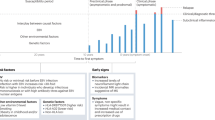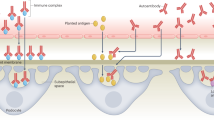Abstract
Mannose-binding lectin (MBL2) variants that decrease the plasma level of the protein or encode dysfunctional proteins are frequently associated with the severity of a number of infections and autoimmune disorders. The high frequencies of these variants in most populations of the world are probably maintained by some selective advantage against widespread diseases. We found 14 new MBL2 allelic haplotypes, two of them with non-synonymous variants, by screening 136 children with uncomplicated malaria, 131 children with severe malaria and 39 older healthy schoolchildren. We also found a significant association of a novel variant with susceptibility to severe malaria (P=0.010). Increased MBL plasma levels and corresponding MBL2 genotypes were associated with lower concentration of several cytokines and chemokines in plasma of malaria patients. We suggest that malaria could have been one of the evolutionary driving forces shaping the MBL2 polymorphism in the African population.
This is a preview of subscription content, access via your institution
Access options
Subscribe to this journal
Receive 6 digital issues and online access to articles
$119.00 per year
only $19.83 per issue
Buy this article
- Purchase on Springer Link
- Instant access to full article PDF
Prices may be subject to local taxes which are calculated during checkout



Similar content being viewed by others
References
World Health Organisation Communicable diseases cluster. Severe falciparum malaria. Trans R Soc Trop Med Hyg 2000; 94: 1–94.
Rich SM, Licht MC, Hudson RR, Ayala FJ . Malaria's Eve: evidence of a recent population bottleneck throughout the world populations of Plasmodium falciparum. Proc Natl Acad Sci USA 1998; 95: 4425–4430.
Ayi K, Turrini F, Piga A, Arese P . Enhanced phagocytosis of ring-parasitized mutant erythrocytes: a common mechanism that may explain protection against falciparum malaria in sickle trait and beta-thalassemia trait. Blood 2004; 104: 3364–3371.
Hill AV, Allsopp CE, Kwiatkowski D, Anstey NM, Twumasi P, Rowe PA et al. Common west African HLA antigens are associated with protection from severe malaria. Nature 1991; 352: 595–600.
Mazier D, Nitcheu J, Idrissa-Boubou M . Cerebral malaria and immunogenetics. Parasite Immunol 2000; 22: 613–623.
Kun JFJ, Mordmüller B, Lell B, Lehman LG, Luckner D, Kremsner PG . Polymorphism in the promoter region of the inducible nitric oxide synthase gene and protection against malaria. Lancet 1998; 351: 265–266.
Koch O, Awomoyi A, Usen S, Jallow M, Richardson A, Hull J et al. IFNGR1 gene promoter polymorphisms and susceptibility to cerebral malaria. J Infect Dis 2002; 185: 1684–1687.
Garred P, Nielsen MA, Kurtzhals JA, Malhotra R, Madsen HO, Goka BQ et al. Mannose-binding lectin is a disease modifier in clinical malaria and may function as opsonin for Plasmodium falciparum-infected erythrocytes. Infect Immun 2003; 71: 5245–5253.
Luty AJF, Kun JFJ, Kremsner PG . Mannose-binding lectin plasma levels and gene polymorphisms in Plasmodium falciparum malaria. J Infect Dis 1998; 178: 1221–1224.
Jack DL, Turner MW . Anti-microbial activities of mannose-binding lectin. Biochem Soc Trans 2003; 31: 753–757.
Klabunde J, Uhlemann AC, Tebo AE, Kimmel J, Schwarz RT, Kremsner PG et al. Recognition of Plasmodium falciparum proteins by mannan-binding lectin, a component of the human innate immune system. Parasitol Res 2002; 88: 113–117.
Jüliger S, Luckner D, Mordmüller B, May J, Weierich A, Lell B et al. Promoter variants of the human mannose-binding lectin gene show different binding. Biochem Biophys Res Commun 2000; 275: 617–622.
Madsen HO, Garred P, Thiel S, Kurtzhals JA, Lamm LU, Ryder LP et al. Interplay between promoter and structural gene variants control basal serum level of mannan-binding protein. J Immunol 1995; 155: 3013–3020.
Ip WK, Chan SY, Lau CS, Lau YL . Association of systemic lupus erythematosus with promoter polymorphisms of the mannose-binding lectin gene. Arthritis Rheum 1998; 41: 1663–1668.
Madsen HO, Satz ML, Hogh B, Svejgaard A, Garred P . Different molecular events result in low protein levels of mannan-binding lectin in populations from southeast Africa and South America. J Immunol 1998; 161: 3169–3175.
Roos A, Garred P, Wildenberg ME, Lynch NJ, Munoz JR, Zuiverloon TC et al. Antibody-mediated activation of the classical pathway of complement may compensate for mannose-binding lectin deficiency. Eur J Immunol 2004; 34: 2589–2598.
Steffensen R, Thiel S, Varming K, Jersild C, Jensenius JC . Detection of structural gene mutations and promoter polymorphisms in the mannan-binding lectin (MBL) gene by polymerase chain reaction with sequence-specific primers. J Immunol Methods 2000; 241: 33–42.
Terai I, Kobayashi K, Matsushita M, Miyakawa H, Mafune N, Kikuta H . Relationship between gene polymorphisms of mannose-binding lectin (MBL) and two molecular forms of MBL. Eur J Immunol 2003; 33: 2755–2763.
Lee SG, Yum JS, Moon HM, Kim HJ, Yang YJ, Kim HL et al. Analysis of mannose-binding lectin 2 (MBL2) genotype and the serum protein levels in the Korean population. Mol Immunol 2005; 42: 969–977.
Larsen F, Madsen HO, Sim RB, Koch C, Garred P . Disease-associated mutations in human mannose-binding lectin compromise oligomerization and activity of the final protein. J Biol Chem 2004; 279: 21302–21311.
Eisen DP, Minchinton RM . Impact of mannose-binding lectin on susceptibility to infectious diseases. Clin Infect Dis 2003; 37: 1496–1505.
Kilpatrick DC . Mannan-binding lectin and its role in innate immunity. Transfus Med 2002; 12: 335–352.
Mullighan CG, Marshall SE, Bunce M, Welsh KI . Variation in immunoregulatory genes determines the clinical phenotype of common variable immunodeficiency. Genes Immun 1999; 1: 137–148.
Seibold F, Konrad A, Flogerzi B, Seibold-Schmid B, Arni S, Jüliger S et al. Genetic variants of the mannan-binding lectin are associated with immune reactivity to mannans in Crohn's disease. Gastroenterology 2004; 127: 1076–1084.
Soborg C, Madsen HO, Andersen AB, Lillebaek T, Kok-Jensen A, Garred P . Mannose-binding lectin polymorphisms in clinical tuberculosis. J Infect Dis 2003; 188: 777–782.
de Miranda Santos IKF, Costa CH, Krieger H, Feitosa MF, Zurakowski D, Fardin B et al. Mannan-binding lectin enhances susceptibility to visceral leishmaniasis. Infect Immun 2001; 69: 5212–5215.
Rector A, Lemey P, Laffut W, Keyaerts E, Struyf F, Wollants E et al. Mannan-binding lectin (MBL) gene polymorphisms in ulcerative colitis and Crohn's disease. Genes Immun 2001; 2: 323–328.
Schafranski MD, Stier A, Nisihara R, Messias-Reason IJ . Significantly increased levels of mannose-binding lectin (MBL) in rheumatic heart disease: a beneficial role for MBL deficiency. Clin Exp Immunol 2004; 138: 521–525.
Husby S, Herskind AM, Jensenius JC, Holmskov U . Heritability estimates for the constitutional levels of the collectins mannan-binding lectin and lung surfactant protein D. A study of unselected like-sexed mon- and dizygotic twins at the age of 6–9 years. Immunology 2002; 106: 389–394.
Bernig T, Taylor JG, Foster CB, Staats B, Yeager M, Chanock SJ . Sequence analysis of the mannose-binding lectin (MBL2) gene reveals a high degree of heterozygosity with evidence of selection. Genes Immun 2004; 5: 461–476.
Luty AJ, Perkins DJ, Lell B, Schmidt-Ott R, Lehman LG, Luckner D et al. Low interleukin-12 activity in severe Plasmodium falciparum malaria. Infect Immun 2000; 68: 3909–3915.
Bernig T, Breunis W, Brouwer N, Hutchinson A, Welch R, Roos D et al. An analysis of genetic variation across the MBL2 locus in Dutch Caucasians indicates that 3′ haplotypes could modify circulating levels of mannose-binding lectin. Hum Genet 2005; 118: 404–415.
Jack DL, Read RC, Tenner AJ, Frosch M, Turner MW, Klein NJ . Mannose-binding lectin regulates the inflammatory response of human professional phagocytes to Neisseria meningitidis serogroup B. J Infect Dis 2001; 184: 1152–1162.
Bellamy R, Ruwende C, McAdam KPWJ, Thursz M, Sumiya M, Summerfield J et al. Mannose binding protein deficiency is not associated with malaria, hepatitis B carriage nor tuberculosis in Africans. Q J Med 1998; 91: 13–18.
Kun JFJ, Schmidt-Ott R, Lehman LG, Lell B, Luckner D, Greve B et al. Merozoite surface antigen 1 and 2 genotyping and rosetting of Plasmodium falciparum in severe versus mild malaria in Lambaréné, Gabon. Trans R Soc Trop Med Hyg 1998; 92: 110–114′.
Luckner D, Lell B, Greve B, Lehman LG, Schmidt-Ott RJ, Matousek P et al. No influence of socioeconomic factors on severe malarial anaemia, hyperparasitaemia or reinfection. Trans R Soc Trop Med Hyg 1998; 92: 478–481.
Boldt AB, Petzl-Erler ML . A new strategy for mannose-binding lectin gene haplotyping. Hum Mutat 2002; 19: 296–306.
den Dunnen JT, Antonarakis SE . Mutation nomenclature extensions and suggestions to describe complex mutations: a discussion. Hum Mutat 2000; 15: 7–12.
Acknowledgements
The subjects of this investigation were informed about the aims of the study and their consent to participate is gratefully acknowledged. We thank Andrea Weierich and Silvelia Grummes for excellent technical assistance, and the Bio-Rad Laboratories staff for kindly providing the equipment and reagents necessary for the BioPlex cytokine multiplex assays. This work was supported by a grant of the NGFN (Nationales Genomforschungsnetz 01GS0114) to JFJ Kun and by a CNPq (Conselho Nacional de Desenvolvimento Científico e Tecnológico, Brazil) PhD scholarship for ABW Boldt.
Author information
Authors and Affiliations
Corresponding author
Rights and permissions
About this article
Cite this article
Boldt, A., Luty, A., Grobusch, M. et al. Association of a new mannose-binding lectin variant with severe malaria in Gabonese children. Genes Immun 7, 393–400 (2006). https://doi.org/10.1038/sj.gene.6364312
Received:
Revised:
Accepted:
Published:
Issue Date:
DOI: https://doi.org/10.1038/sj.gene.6364312
Keywords
This article is cited by
-
Association of mannose binding lectin with chronic obstructive pulmonary disease susceptibility and its clinical outcomes
Molecular Biology Reports (2023)
-
A comprehensive in silico analysis of non-synonymous and regulatory SNPs of human MBL2 gene
SpringerPlus (2016)
-
Polymorphisms in host genes encoding NOSII, C-reactive protein, and adhesion molecules thrombospondin and E-selectin are risk factors for Plasmodium falciparum malaria in India
European Journal of Clinical Microbiology & Infectious Diseases (2015)
-
Variations in ncRNA gene LOC284889 and MIF-794CATT repeats are associated with malaria susceptibility in Indian populations
Malaria Journal (2013)
-
Susceptibility to Leprosy is Associated with M-ficolin Polymorphisms
Journal of Clinical Immunology (2013)



